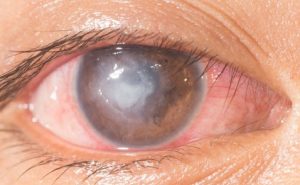What is a rare disease
According to the World Health Organisation (WHO) definition, a disease can be defined as “rare' if it occurs with a frequency of less than 6.5 to 10 people per 10,000, although this number varies in different countries, depending on the organisation of the national health system and population.
In general, there are three elements that make it possible to define a particular disease as 'rare' for a given country:
- the total number of people affected by the disease
- the prevalence of pathology
- the lack of treatment for that specific disorder
So far, between 5,000 and 8,000 rare diseases have been recognised, most of which have a genetic origin.
The prevalence of rare diseases is estimated between 6% and 8%.
Rare eye and nervous system diseases
Some rare diseases affect eyesight, either directly or as a consequence of diseases that, for example, affect the nervous system.
Again, these are often genetic disorders, many of which can be traced back to abnormalities in the development of the neural crest in the embryo, which gives rise to the eye structures, but not only. Let us look at some of them.
Rare eye diseases
Retinitis pigmentosa
People born with a genetically based disease slowly lose their sight as they grow older.
The disease begins with difficulty seeing at night or difficulty with peripheral vision. Gradually, colour vision fades and patients also have difficulty with central vision.
Although tools and devices for the visually impaired can be helpful, there is still no specific cure for this disease.
Retinitis pigmentosa affects about 25 out of 100,000 people.
Retinoblastoma
It is a tumour of the eye that predominantly affects children under the age of five.
Retinal cells undergo alterations that trigger uncontrolled cell growth, causing a tumour to form in one or both eyes.
Since this cancer is hereditary, siblings and children of these patients may also be at risk of developing the disease.
Early diagnosis and treatment are essential to preserve sight and save the child's life.
Treatments include chemotherapy, laser therapy, cold therapy (cryotherapy) and surgery.
It affects about 6 out of 100,000 people.
Acanthamoeba keratitis
 This is a rare eye infection, but one with potentially very serious consequences for vision and which occurs mainly in contact lens wearers. Additional risk factors are the presence of damage to the corneal surface and exposure to contaminated water.
This is a rare eye infection, but one with potentially very serious consequences for vision and which occurs mainly in contact lens wearers. Additional risk factors are the presence of damage to the corneal surface and exposure to contaminated water.
There is currently no authorised drug for the treatment of Acanthamoeba keratitis in any country, but a polyhexanide (PHMB) drug for ophthalmic use, indicated for the treatment of Acanthamoeba keratitis, has recently been developed and is expected to be approved in Europe by 2023.
The approval of polyhexanide therapy would finally make a specific treatment available for this disease, which affects about 2 in 100,000 people.
Optic neuritis
It is an inflammation of the nerve that can blur vision and make eye movement painful. Optic neuritis can result from an infection or an autoimmune disease such as neuromyelitis optica (also a rare disease). It can also occur as a side effect of certain medications.
Optic neuritis is often treated with steroids and affects about 115 out of 100,000 people.
Stargardt's disease
Stargardt's disease (juvenile macular degeneration) is a condition that can go unnoticed until adolescence or adulthood, when people develop blurred or distorted vision.
Vision loss is progressive and can reach the level of legal blindness. This occurs when light-sensitive cells in the macula die.
It affects up to 12 out of 100,000 people.
Anophthalmia or microphthalmia
Infants with these conditions are born without an eye (anophthalmia) or with very small eyes (microphthalmia).
There is no cure, but ophthalmologists can protect the child's residual vision and prosthetic eyes can be designed to improve the appearance.
It affects about 10 out of 100,000 children.
Axenfeld-Rieger syndrome
People with this syndrome may present with various types of eye problems, from a thin iris to an off-centre pupil. In some cases, the disease also affects the cornea.
About half of all patients develop glaucoma and are at risk of severe vision loss. Glaucoma can be treated with eye drops or surgery. Some patients experience glare or sensitivity to light and find relief with special lenses or contacts.
It affects less than 1 in 100,000 people.
Myasthenia gravis
The myasthenia gravis (MG) is a chronic autoimmune disease, which involves the neuromuscular junction and which in the majority of patients, approximately 90% of cases, results in ocular involvement that manifests itself with clinical pictures of varying severity and with symptoms of blurred vision and problems with balance and unsteady gait.
Myasthenia gravis is a rare diseasewith an estimated prevalence of 1/5,000 and an incidence of 1/250,000-1/33,000 in Europe. It affects both sexes, with a difference in the time of onset, which in females occurs predominantly before the age of 40 (early onset), while in males after the age of 50 (late onset).
Cogan syndrome
 The disease predominantly affects young adults, with an age of onset between 20 and 30 years, while it is uncommon in children.
The disease predominantly affects young adults, with an age of onset between 20 and 30 years, while it is uncommon in children.
The clinical onset is characterised systemically by fever, fatigue and weight loss.
They are frequent auditory symptomssuch as tinnitus and reduced hearing, and ocular symptomssuch as photophobia, oscillopsia and recurrent inflammation of the cornea.
Prevalence figures are not known at the moment: it is in any case a very rare disease, with about 250 cases described worldwide.
The importance of rare disease registries
The need to identify and monitor rare eye diseases is growing because of the impact these diseases have in terms of serious public health problems.
In several countries registers of rare diseases that include lists of diseases, their characteristics, and recommendations for patient care. The establishment of specific registers for rare eye diseases, which are emerging in some countries, would have a positive impact on both patients' lives and scientific research opportunities.
- Mohan R. Eye of the beholder: Rare eye diseases in focus. J Neurosci Res. 2019 Jan;97(1):3-6.
- Sharma M, Jain N, Singh V, Singla S, Aftab I. Ophthalmic registries for rare eye diseases. Indian J Ophthalmol. 2022 Jul;70(7):2225-2230.
- 20 Rare Eye Conditions That Ophthalmologists Treat, American Acadmey of Ophtalmology https://www.aao.org/eye-health/tips-prevention/20-rare-eye-conditions-that-ophthalmologists-treat
- Nora Szentmary et al, Acanthamoeba keratitis and Clinical signs, differential diagnosis and treatment, J Curr Ophthalmol. 2018 Oct 19;31(1):16-23. doi: 10.1016/j.joco.2018.09.008. eCollection 2019 Mar.
